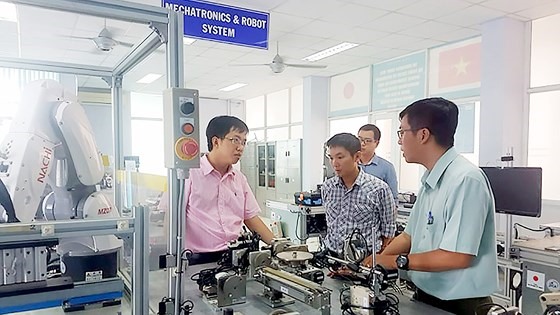 Society
Society

Việt Nam, with its open and internationally integrated economy, had been enjoying a ‘golden population’ period with a high number of working-age people. However, the quality of the labour force was not ‘golden’, experts said at a conference yesterday in Hà Nội.
 |
| Việt Nam needed strategic breakthrough measures to create a plentiful and highly qualified workforce to meet the requirements of the Fourth Industrial Revolution (Industry 4.0).– Photo sggp.org.vn |
HÀ NỘI – Việt Nam, with its open and internationally integrated economy, had been enjoying a ‘golden population’ period with a high number of working-age people. However, the quality of the labour force was not ‘golden’, experts said at a conference yesterday in Hà Nội.
The country needed strategic breakthrough measures to create a plentiful and highly qualified workforce to meet the requirements of the Fourth Industrial Revolution (Industry 4.0).
Vũ Quang Thọ, director of the Việt Nam General Confederation of Labour’s Institute of Workers and Trade Union, said the Industry 4.0 had created a series of positive changes in technology, but had also impacted the Vietnamese labour market.
Many jobs would be replaced by robotic automation. If labourers did not adapt to the demands of the new industry, they could easily fall into unemployment, he said.
Thọ said the Vietnamese labour force was young, but low-quality. Currently, only about 20 per cent of Vietnamese labourers had been technically trained.
In addition, training structure remained limited, causing a shortage of workers with skills or special training.
Nguyễn Văn Thuật from the National Centre for Socio-Economic Information and Forecasting, said more than 43 million labourers, accounting for 77 per cent of the total workforce, did not have technical qualifications.
Thuật described it a big obstacle for socio-economic development, saying it was not easy to remove in a short period of time.
Figures from the centre showed that the number of unskilled labourers had only fallen slightly between 2012 and 2017. Most were agricultural labourers, freelancers and workers in the informal sector. Their jobs were reportedly unstable and brought low incomes.
Thuật said these jobs would disappear rapidly in the near future when enterprises took advantage of modern machinery and technology to replace inadequate human resources.
At the conference, experts said that Việt Nam should focus on solving the shortage of technically skilled labourers by training highly-qualified workers in new industry sectors.
The country needed to improve and complete its legal system and labour market policies to continue developing the quality of its labour market, gradually switching unskilled labourers to qualified workers, and bringing positive changes such as increasing salaries.
They also suggested that the country’s education policies needed to be changed to meet the demands of the revolution. The combination of learning about large data technology and machinery should be applied to ensure social security.
The introduction of Artificial Intelligence should be applied in labour management and employment connections between workers and enterprises. The construction of a digital platform for social security would provide careers for labourers at different skill levels, they said. – VNS




